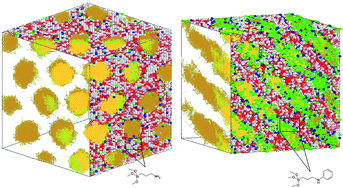One-pot synthesis of amino functionalized mesoporous silica materials: using simulations to understand transitions between different structures
Abstract
The rich phase behavior of

a
Soft Condensed Matter, Debye Institute for Nanomaterials Science, Utrecht University, Princetonplein 5, Utrecht, The Netherlands
E-mail:
a.patti@uu.nl
b Departament d'Enginyeria Química, Universitat Rovira i Virgili, Av. Països Catalans, 26, Tarragona, Spain
c Department of Inorganic Chemistry, Faculty of Science, P. J. Safarik University, Kosice, Slovak Republic
d School of Chemical Engineering and Analytical Science, University of Manchester, Manchester, UK
The rich phase behavior of

 Please wait while we load your content...
Something went wrong. Try again?
Please wait while we load your content...
Something went wrong. Try again?
A. Patti, A. D. Mackie, V. Zelenak and F. R. Siperstein, J. Mater. Chem., 2009, 19, 724 DOI: 10.1039/B813016G
To request permission to reproduce material from this article, please go to the Copyright Clearance Center request page.
If you are an author contributing to an RSC publication, you do not need to request permission provided correct acknowledgement is given.
If you are the author of this article, you do not need to request permission to reproduce figures and diagrams provided correct acknowledgement is given. If you want to reproduce the whole article in a third-party publication (excluding your thesis/dissertation for which permission is not required) please go to the Copyright Clearance Center request page.
Read more about how to correctly acknowledge RSC content.
 Fetching data from CrossRef.
Fetching data from CrossRef.
This may take some time to load.
Loading related content
